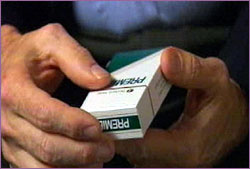Related Research Articles

Premier was an American brand of smokeless cigarettes which was owned and manufactured by the R.J. Reynolds Tobacco Company (RJR). Premier was released in the United States in 1988. It was the first commercial heated tobacco product. However, it was difficult to use and tasted unpleasant; as a result, it was unpopular with consumers. A commercial failure, the brand was a significant financial loss for RJR and was quickly taken off the market.

Snus is a tobacco product, originating from a variant of dry snuff in early 18th-century Sweden. It is placed between the upper lip and gum for extended periods, as a form of sublabial administration. Snus is not fermented. Although used similarly to American dipping tobacco, snus does not typically result in the need for spitting and, unlike naswar, snus is steam-pasteurized.

A vaporizer or vaporiser, colloquially known as a vape, is a device used to vaporize substances for inhalation. Plant substances can be used, commonly cannabis, tobacco, or other herbs or blends of essential oil. However, they are most commonly filled with a combination propylene glycol, glycerin, and drugs such as nicotine or tetrahydrocannabinol as a liquid solution.

Nicotine marketing is the marketing of nicotine-containing products or use. Traditionally, the tobacco industry markets cigarette smoking, but it is increasingly marketing other products, such as electronic cigarettes and heated tobacco products. Products are marketed through social media, stealth marketing, mass media, and sponsorship. Expenditures on nicotine marketing are in the tens of billions a year; in the US alone, spending was over US$1 million per hour in 2016; in 2003, per-capita marketing spending was $290 per adult smoker, or $45 per inhabitant. Nicotine marketing is increasingly regulated; some forms of nicotine advertising are banned in many countries. The World Health Organization recommends a complete tobacco advertising ban.

Philip Morris International Inc. (PMI) is an American multinational tobacco company, with products sold in over 180 countries. The most recognized and best selling product of the company is Marlboro. Philip Morris International is often referred to as one of the companies comprising Big Tobacco.

Smokeless tobacco is a tobacco product that is used by means other than smoking. Their use involves chewing, sniffing, or placing the product between gum and the cheek or lip. Smokeless tobacco products are produced in various forms, such as chewing tobacco, snuff, snus, and dissolvable tobacco products. Smokeless tobacco products typically contain over 3000 constituents. All smokeless tobacco products contain nicotine and are therefore highly addictive. Quitting smokeless tobacco use is as challenging as smoking cessation.

An electronic cigarette or vape is a device that simulates tobacco smoking. It consists of an atomizer, a power source such as a battery, and a container such as a cartridge or tank filled with liquid. Instead of smoke, the user inhales vapor. As such, using an e-cigarette is often called "vaping". The atomizer is a heating element that vaporizes a liquid solution called e-liquid, which quickly cools into an aerosol of tiny droplets, vapor and air. E-cigarettes are activated by taking a puff or pressing a button. Some look like traditional cigarettes, and most kinds are reusable. The vapor mainly comprises propylene glycol and/or glycerin, usually with nicotine and flavoring. Its exact composition varies, and depends on several things including user behavior.
Smoking in South Korea has decreased overall for both men and women in the past decades. However, a high prevalence of tobacco use is still observed, especially with the rise of novel tobacco products like e-cigarettes and heat-not-burn tobacco products. There are socioeconomic inequalities in smoking prevalence according to gender, income, education, and occupational class. Advocates call for measures to reduce the smoking rates and address smoking inequalities using a combination of monitoring and tobacco control policies. These measures include significant price hikes, mandatory warning photos on cigarette packs, advertising bans, financial incentives, medical help for quitting, and complete smoking bans in public places.

blu is an electronic cigarette brand, produced by Fontem Ventures and owned by Imperial Brands. The brand blu sells various types of rechargeable and disposable e-cigarettes with a wide selection of flavored and unflavored liquids. Its products are available in many countries and each market offers different types of products suited to public demand and opportunities. The global headquarters of blu is located in Amsterdam. Local offices are active around the world to service all markets which sell the brand.
The use of electronic cigarettes (vaping) carries health risks. The risk depends on the fluid and varies according to design and user behavior. In the United Kingdom, vaping is considered by some to be around 95% less harmful than tobacco after a controversial landmark review by Public Health England.

An electronic cigarette is a handheld battery-powered vaporizer that simulates smoking, but without tobacco combustion. E-cigarette components include a mouthpiece, a cartridge, a heating element/atomizer, a microprocessor, a battery, and some of them have an LED light on the end. An atomizer consists of a small heating element, or coil, that vaporizes e-liquid and a wicking material that draws liquid onto the coil. When the user inhales a flow sensor activates the heating element that atomizes the liquid solution; most devices are manually activated by a push-button. The e-liquid reaches a temperature of roughly 100–250 °C (212–482 °F) within a chamber to create an aerosolized vapor. The user inhales an aerosol, which is commonly but inaccurately called vapor, rather than cigarette smoke. Vaping is different from smoking, but there are some similarities, including the hand-to-mouth action of smoking and a vapor that looks like cigarette smoke. The aerosol provides a flavor and feel similar to tobacco smoking. There is a learning curve to use e-cigarettes properly. E-cigarettes are cigarette-shaped, and there are many other variations. E-cigarettes that resemble pens or USB memory sticks are also sold that may be used unobtrusively.

The chemical composition of the electronic cigarette aerosol varies across and within manufacturers. Limited data exists regarding their chemistry. However, researchers at Johns Hopkins University analyzed the vape clouds of popular brands such as Juul and Vuse, and found "nearly 2,000 chemicals, the vast majority of which are unidentified."

A vape shop is a retail outlet specializing in the selling of vaping products, though shops selling derived psychoactive cannabis products have increased since the passage of the 2018 Farm Bill. There are also online vape shops. A vape shop offers a range of vaping products. The majority of vape shops do not sell vaping products that are from "Big Tobacco" companies. In 2013, online search engine searches on vape shops surpassed searches on e-cigarettes. Around a third of all sales of vaping products take place in vape shops. Big Tobacco believes the independent vape market is a threat to their interests.
A heated tobacco product (HTP) is a tobacco product that heats the tobacco at a lower temperature than conventional cigarettes. These products contain nicotine, which is a highly addictive chemical. The heat generates an aerosol or smoke to be inhaled from the tobacco, which contains nicotine and other chemicals. HTPs may also contain additives not found in tobacco, including flavoring chemicals. HTPs generally heat tobacco to temperatures under 600 °C (1100 °F), a lower temperature than conventional cigarettes.

Iqos is a line of heated tobacco and electronic cigarette products manufactured by Philip Morris International (PMI). It was first introduced in November 2014 in Japan and Italy. Most of the IQOS products are devices that heat tobacco without burning it.

The usage of electronic cigarettes has risen rapidly since their introduction to the market in 2002. The global number of adult e-cigarettes users rose from about 7 million in 2011 to between 68 million and 82 million in 2021. Awareness and use of e-cigarettes greatly increased over the few years leading up to 2014, particularly among young people and women in some parts of the world. Since their introduction vaping has increased in the majority of high-income countries. E-cigarette use in the US and Europe is higher than in other countries, except for China which has the greatest number of e-cigarette users. Growth in the UK as of January 2018 had reportedly slowed since 2013. The growing frequency of e-cigarette use may be due to heavy promotion in youth-driven media channels, their low cost, and the belief that e-cigarettes are safer than traditional cigarettes, according to a 2016 review. E-cigarette use may also be increasing due to the consensus among several scientific organizations that e-cigarettes are safer compared to combustible tobacco products. E-cigarette use also appears to be increasing at the same time as a rapid decrease in cigarette use in many countries, suggesting that e-cigarettes may be displacing traditional cigarettes.
Exposure to nicotine, from conventional or electronic cigarettes during adolescence can impair the developing human brain. E-cigarette use is recognized as a substantial threat to adolescent behavioral health. The use of tobacco products, no matter what type, is almost always started and established during adolescence when the developing brain is most vulnerable to nicotine addiction. Young people's brains build synapses faster than adult brains. Because addiction is a form of learning, adolescents can get addicted more easily than adults. The nicotine in e-cigarettes can also prime the adolescent brain for addiction to other drugs such as cocaine. Exposure to nicotine and its great risk of developing an addiction, are areas of significant concern.
Electronic cigarettes are marketed to smoking and non-smoking men, women, and children as being safer than cigarettes. E-cigarette businesses have considerably accelerated their marketing spending. All of the large tobacco businesses are engaging in the marketing of e-cigarettes. For the majority of the large tobacco businesses these products are quickly becoming a substantial part of the total advertising spending. E-cigarette businesses have a vested interest in maximizing the number of long-term product users. The entrance of traditional transnational tobacco businesses in the marketing of such products is a serious threat to restricting tobacco use. E-cigarette businesses have been using intensive marketing strategies like those used to publicize traditional cigarettes in the 1950s and 1960s. While advertising of tobacco products is banned in most countries, television and radio e-cigarette advertising in several countries may be indirectly encouraging traditional cigarette use.
Nicotine salts are salts formed from nicotine and an acid. They are found naturally in tobacco leaves. Various acids can be used, leading to different conjugate bases paired with the ammonium form of nicotine.
References
- 1 2 3 4 5 6 7 8 9 10 11 12 13 14 15 Pieper, Elke; Mallock, Nadja; Henkler-Stephani, Frank; Luch, Andreas (2018). "Tabakerhitzer als neues Produkt der Tabakindustrie: Gesundheitliche Risiken" ["Heat not burn" tobacco devices as new tobacco industry products: health risks]. Bundesgesundheitsblatt - Gesundheitsforschung - Gesundheitsschutz (in German). 61 (11): 1422–1428. doi: 10.1007/s00103-018-2823-y . ISSN 1436-9990. PMID 30284624.
 This article incorporates text by Elke Pieper, Nadja Mallock, Frank Henkler-Stephani, and Andreas Luch available under the CC BY 4.0 license.
This article incorporates text by Elke Pieper, Nadja Mallock, Frank Henkler-Stephani, and Andreas Luch available under the CC BY 4.0 license. - 1 2 3 4 5 6 7 Dautzenberg, B.; Dautzenberg, M.-D. (2018). "Le tabac chauffé : revue systématique de la littérature" [Systematic analysis of the scientific literature on heated tobacco]. Revue des Maladies Respiratoires (in French). 36 (1): 82–103. doi: 10.1016/j.rmr.2018.10.010 . ISSN 0761-8425. PMID 30429092.
- 1 2 3 4 5 Kaur, Gurjot; Muthumalage, Thivanka; Rahman, Irfan (2018). "Mechanisms of toxicity and biomarkers of flavoring and flavor enhancing chemicals in emerging tobacco and non-tobacco products". Toxicology Letters. 288: 143–155. doi:10.1016/j.toxlet.2018.02.025. ISSN 0378-4274. PMC 6549714 . PMID 29481849.
- ↑ Jenssen, Brian P.; Walley, Susan C.; McGrath-Morrow, Sharon A. (2017). "Heat-not-Burn Tobacco Products: Tobacco Industry Claims No Substitute for Science". Pediatrics. 141 (1): e20172383. doi: 10.1542/peds.2017-2383 . ISSN 0031-4005. PMID 29233936.
- ↑ Ziedonis, Douglas; Das, Smita; Larkin, Celine (2017). "Tobacco use disorder and treatment: New challenges and opportunities". Dialogues in Clinical Neuroscience. 19 (3): 271–80. doi:10.31887/DCNS.2017.19.3/dziedonis. PMC 5741110 . PMID 29302224.
- 1 2 3 4 5 6 7 8 Kaunelienė, Violeta; Meišutovič-Akhtarieva, Marija; Martuzevičius, Dainius (2018). "A review of the impacts of tobacco heating system on indoor air quality versus conventional pollution sources". Chemosphere. 206: 568–578. Bibcode:2018Chmsp.206..568K. doi: 10.1016/j.chemosphere.2018.05.039 . ISSN 0045-6535. PMID 29778082.
- 1 2 3 4 5 6 7 McNeill 2018, p. 210.
- 1 2 McNeill 2018, p. 219.
- 1 2 Elias, Jesse; Dutra, Lauren M; St. Helen, Gideon; Ling, Pamela M (2018). "Revolution or redux? Assessing IQOS through a precursor product". Tobacco Control. 27 (Suppl 1): s102–s110. doi:10.1136/tobaccocontrol-2018-054327. ISSN 0964-4563. PMC 6238084 . PMID 30305324.
- 1 2 Staal, Yvonne CM; van de Nobelen, Suzanne; Havermans, Anne; Talhout, Reinskje (2018). "New Tobacco and Tobacco-Related Products: Early Detection of Product Development, Marketing Strategies, and Consumer Interest". JMIR Public Health and Surveillance. 4 (2): e55. doi: 10.2196/publichealth.7359 . ISSN 2369-2960. PMC 5996176 . PMID 29807884.
 This article incorporates text by Yvonne CM Staal, Suzanne van de Nobelen, Anne Havermans, and Reinskje Talhout available under the CC BY 4.0 license.
This article incorporates text by Yvonne CM Staal, Suzanne van de Nobelen, Anne Havermans, and Reinskje Talhout available under the CC BY 4.0 license. - ↑ Shi, Yuyan; Caputi, Theodore L.; Leas, Eric; Dredze, Mark; Cohen, Joanna E.; Ayers, John W. (2017). "They're heating up: Internet search query trends reveal significant public interest in heat-not-burn tobacco products". PLOS ONE. 12 (10): e0185735. Bibcode:2017PLoSO..1285735C. doi: 10.1371/journal.pone.0185735 . ISSN 1932-6203. PMC 5636077 . PMID 29020019.
 This article incorporates text by Theodore L. Caputi, Eric Leas, Mark Dredze, Joanna E. Cohen, and John W. Ayers available under the CC BY 4.0 license.
This article incorporates text by Theodore L. Caputi, Eric Leas, Mark Dredze, Joanna E. Cohen, and John W. Ayers available under the CC BY 4.0 license. - ↑ Bialous, Stella A; Glantz, Stanton A (2018). "Heated tobacco products: another tobacco industry global strategy to slow progress in tobacco control". Tobacco Control. 27 (Suppl 1): s111–s117. doi:10.1136/tobaccocontrol-2018-054340. ISSN 0964-4563. PMC 6202178 . PMID 30209207.
 This article incorporates text by Stella A Bialous and Stanton A Glantz available under the CC BY 4.0 license.
This article incorporates text by Stella A Bialous and Stanton A Glantz available under the CC BY 4.0 license. - 1 2 "Heated tobacco products (HTPs) information sheet". World Health Organization. May 2018.
- 1 2 3 4 McNeill 2018, p. 216.
- 1 2 Górski, Paweł (2019). "E-cigarettes or heat-not-burn tobacco products – advantages or disadvantages for the lungs of smokers". Advances in Respiratory Medicine. 87 (2): 123–134. doi: 10.5603/ARM.2019.0020 . ISSN 2543-6031. PMID 31038725.
- ↑ Li, Xiangyu; Luo, Yanbo; Jiang, Xingyi; Zhang, Hongfei; Zhu, Fengpeng; Hu, Shaodong; Hou, Hongwei; Hu, Qingyuan; Pang, Yongqiang (2019). "Chemical Analysis and Simulated Pyrolysis of Tobacco Heating System 2.2 Compared to Conventional Cigarettes". Nicotine & Tobacco Research. 21 (1): 111–118. doi:10.1093/ntr/nty005. ISSN 1462-2203. PMID 29319815.
